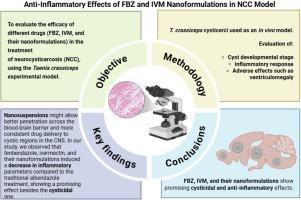Nanosuspensions of fenbendazole and ivermectin induce parasite death and low inflammatory response in experimental neurocysticercosis
IF 2.5
3区 医学
Q2 PARASITOLOGY
引用次数: 0
Abstract
Neurocysticercosis (NCC) is the most common preventable infectious disease of the central nervous system (CNS) worldwide. Its treatment is performed with anthelmintics, albendazole, or praziquantel, associated with corticosteroids due to the intense inflammatory response after the parasite’s death. Also, the current treatment does not achieve full parasitic clearance and as it is used for over 40 years, there are a few reports on parisitic resistance and drug refractoriness. Other anthelminthic drugs in their commercial or nanoformulation form may present important activity against cysticerci and may present a therapeutic alternative to the current treatment. This study aimed the histopathologic evaluation of fenbendazole (FBZ), ivermectin (IVM), and their nanoformulations against an experimental model of NCC. Balb/c mice were intracranially inoculated with Taenia crassiceps cysticerci and treated with FBZ and FBZ nanoformulated (60mg/kg), IVM and IVM nanoformulated (0.2 mg/kg), albendazole (ABZ) (40 mg/kg) and 0.9 % NaCl (control group). After the animal’s euthanasia, the brains were removed and histopathologically analyzed. It was possible to observe the degradation of the parasite in all groups treated with anthelminthic drugs, however, the inflammatory response was significantly lower in the groups treated with FBZ, IVM, and their nanoformulations in comparison to Albendazole and control groups. In agreement with these results, nanosuspensions might allow better penetration across the blood-brain barrier and more consistent drug delivery to cystic regions in the CNS.

芬苯达唑和伊维菌素纳米混悬液诱导实验性神经囊虫病的寄生虫死亡和低炎症反应。
神经囊虫病(NCC)是全球最常见的可预防的中枢神经系统(CNS)传染病。由于寄生虫死后出现强烈的炎症反应,其治疗采用驱虫药、阿苯达唑或吡喹酮,并伴有皮质类固醇。此外,目前的治疗方法并不能完全清除寄生虫,而且由于它已经使用了40多年,因此有一些关于寄生虫耐药性和药物难治性的报道。其他商业或纳米制剂形式的驱虫药可能对囊虫具有重要的活性,并可能成为目前治疗的替代方案。本研究旨在对芬苯达唑(FBZ)、伊维菌素(IVM)及其纳米制剂对NCC实验模型的组织病理学评价。Balb/c小鼠脑内接种带绦虫囊尾蚴后,分别用FBZ和FBZ纳米制剂(60mg/kg)、IVM和IVM纳米制剂(0.2 mg/kg)、阿苯达唑(ABZ) (40 mg/kg)和0.9% NaCl(对照组)处理。动物安乐死后,大脑被移除并进行组织病理学分析。用驱虫药治疗的所有组都可以观察到寄生虫的降解,然而,与阿苯达唑和对照组相比,用FBZ、IVM及其纳米制剂治疗的组的炎症反应明显较低。与这些结果一致的是,纳米悬浮液可以更好地穿透血脑屏障,并更一致地将药物输送到中枢神经系统的囊性区域。
本文章由计算机程序翻译,如有差异,请以英文原文为准。
求助全文
约1分钟内获得全文
求助全文
来源期刊

Acta tropica
医学-寄生虫学
CiteScore
5.40
自引率
11.10%
发文量
383
审稿时长
37 days
期刊介绍:
Acta Tropica, is an international journal on infectious diseases that covers public health sciences and biomedical research with particular emphasis on topics relevant to human and animal health in the tropics and the subtropics.
 求助内容:
求助内容: 应助结果提醒方式:
应助结果提醒方式:


